And in those days ten years ago, King Gelandestrasse of Bavaria was just 30 years old and feeling his hafer, a yuuge success throughout the world upon which everyone with encroaching male-pattern baldness wanted to ride to Zimbabwe. On the other side of the Alps, the Romans could not help noticing King GS’s success. It was time, then, to upgrade their simple air-cooled playbike with a bewildering array of technological finery also, along with a bunch more of the King’s horses. Why not, as all roads lead to Rome. Placing the turn signals in the handguards was a stroke of genius that declared the battle was on – but no touching of the hair or face. A reading from the book of Pete, and the apostle T-Rod. Amen.
The king is still on his global throne.
|
|
But in recent years other brands have made attempts to loosen the GS’ stranglehold over the on/off-road sector of motorcycling – KTM’s dirt bike-inspired 990 Adventure leaps to mind. However, not until this year has any brand attempted to match the German giant’s ever-growing array of electronic rider aids available on the GS.
The new Multistrada 1200, now powered by a retuned version of the liquid-cooled 1199cc L-Twin sourced from Ducati’s 1198 superbike, has not only gained heaps more power over the previous 1078cc air-cooled Multi, it brings a multitude of e-gizmos.
|
|
Although Ducati doesn’t tout the new ‘Strada as a conqueror of unforgiving backcountry, its MSRP(s), engine performance and rider-manageable electronics package are thinly veiled advances against the GS’s profound share of the A-T market.
A duel between the updated-for-2010 GS and new Multistrada seemed inevitable, so, that’s just what we did.
A battle of upscale gadgetry
We procured a GS ($14,950 base) with the optional Premium Package.
This top-shelf trim level includes extras such as heated grips, saddlebag mounts and BMW’s Integral ABS – which make up the Standard Package $16,400 – as well as Enduro ESA push-button suspension, on-board computer and hand guards. The Premium trim level pushes the GS’s price to $17,695.
BMW’s Enduro ESA adds six rider-selectable damping settings (tailored for off-road use) to the existing nine on-road damping settings from ESA found on BMW’s road-going bikes. Suspension preload settings (rider, rider/gear, rider/passenger for street, Minimum/Maximum Reserves for off-road) combine with damping settings to create a grand total of 15 possible suspension settings.
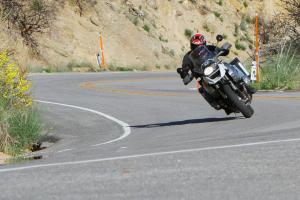 Slicing up serpentine roads is well within the GS’s repertoire.
Slicing up serpentine roads is well within the GS’s repertoire.
It bears noting that only the damping selections are switchable on the fly. Additionally, in order to toggle between on-road and off-road damping choices, as well as for preload choices, the GS must be at a complete stop with the engine running.
BMW’s ABS also requires the bike be at standstill before the rider disables or enables the system.
BMW has its own traction control system called ASC (also disabled by the push of a button), but none of the test units available to the press at the time we requested a GS had the system installed.
Our GS also came equipped with optional spoke wheels ($950) and centerstand ($240). To highlight the GS’s touring capabilities we opted for a set of BMW-branded Vario sidecases ringing in at $466.95 per side.
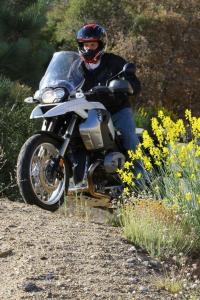 The GS is almost as adept in off-road environs as it is on the road.
The GS is almost as adept in off-road environs as it is on the road.
All totaled, with BMW’s $495 destination charge factored in, the GS retails for $20,313.90.
That’s a steep entry fee by most standards, but when compared to the Multistrada S models, the Beemer comes in as the less expensive bike. Wow. How often does that happen?
Although ABS is a $1500 option on the$14,495 base Multistrada, Ducati’s traction control system with eight levels of intervention, as well as four fuel mapping selections (Sport, Touring, Urban, Enduro), are part and parcel on the entry level Multi.
Sport mode unleashes the full potency of the 1199cc Twin, which churned out 128.7 peak hp at 9250 rpm and 78.6 ft-lbs at 7500 rpm when we ran it on dyno at Gene Thomason Racing (310-704-4544) in Torrance, Calif. Touring mode allows the same peak power, but with a softer delivery. Urban and Enduro modes clip power significantly by limiting throttle openings to 60%.
No big shocker here, but the BMW’s peak ponies fall a fair bit short of the Duc’s.
Still, the GS’s 88.2 hp at 7500rpm provides plenty of poke to get the big traillie down the road briskly. And it’ll cruise the interstate all day long at an indicated 90 mph. The GS’s 68.6 ft-lbs at 6750 rpm torque reading isn’t exactly on par with Multi, but the Beemer produces the lion’s share of its torque early in the rpm range (48.0 ft-lbs by 2000 rpm). And it’s able to keep within a couple ft-lbs of the Duc’s torque output until 5K-ish rpm where the Ducati starts to edge away.
|
|
Like the flagship 1198 superbike and hooligan-maker Streetfighter, an up spec S model is available for the Multi, too.
The Multistrada S Sport features various carbon fiber covers and trim pieces, while the S Touring model forgoes exotic carbon in favor saddlebags, heated grips and a centerstand. But the most impressive and distinctive feature on the S models is the use of Ohlins TTX electronic suspension.
|
|
On the S models, fuel-mapping selections are tied to DTC as well as the electronic suspension to create a series of turnkey settings. For example, in Sport mode the engine’s full power is unbridled, suspension damping is firmer and DTC is set to level 4.
Adding further to the Duc-e-wizardry, a rider can choose from four different load scenarios (rider, rider w/gear, etc) for the suspension compared to three on the BMW. These load settings – indicated by lil’ helmet and luggage icons – compensate for added weight by screwing down spring preload.
|
|
The mapping modes and suspension load changes on the MTS can take place while blitzing along at speed, if you wish. Depending on your needs, the Duc’s on-the-fly adjustments may be perceived as a distinct advantage over the GS’ system. Yet, the GS’s engine is quite manageable and user-friendly, so there doesn’t seem a genuine need to grace it with selectable mapping.
ABS on the MTS can be disabled entirely, as can DTC. Also, DTC allows for level selection (1 for least intrusive, 8 is most intrusive) independent of presets programmed into the system.
Our Multi test mule was an S Sport; and with accessory saddlebags ($849 per pair) it tallied up a $20,844 price tag.
| What We Rode | ||||||||||||||||||||||||||||
We understand the above is a lot of info to consume (you should’ve tried writing it!), so here’s a chart to help easy the flow of data:
|
Two guys after the same girl
The intended target for both scoots is the “adventure” rider. But we’d (ad)venture a guess that most Multis and GSs sold see a fair bit more pavement than boulder-strewn creek beds.
Cutting to the chase, the Multistrada is Master of the Road.
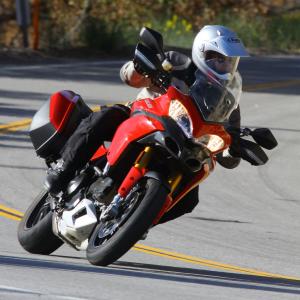 At home and dominating on the pavement, the Multistrada plainly exhibits Ducati sportbike heritage from which it draws heavily.
At home and dominating on the pavement, the Multistrada plainly exhibits Ducati sportbike heritage from which it draws heavily.
At risk of overstating the obvious, the Ducati and its nearly 130 horses sprint away from the GS with little effort. To us the Multistrada is more like a Streetfighter with long travel suspension, a windshield and bodywork. It’ll dive into corners, rail ‘round them, and then use its prodigious-for-an-adventure-bike power to squirt out the other side.
The GS’s Boxer Twin, although peppy in its own right, feels more as if it’s building a head of steam when compared to the Multi’s race-bred powerplant.
Perhaps, though, that’s an oversimplification of the venerable Boxer. Peak power on the BMW is essentially the same as on the previous 1200cc model, but new cylinder heads sourced from the HP2 Sport help the big A-T bike make significant gains in midrange power compared to the previous GS.
The Beemer will easily loft the front skyward in second, and occasionally in third gear, with a little flip of the clutch and a boost from the twist grip. Get into the throttle aggressively from low rpm and the hottest Boxer yet to power a GS accelerates quickly. And by quickly, we mean genuinely quickly, not quickly-for-a-GS quick.
Also, the BMW’s exhaust is surprisingly throaty for, well, a BMW, and it makes a cool burble and pop on engine overrun. I preferred the GS’s note to the Duc’s.

For a bike like the GS, with its proclivities for serious off-road stints, excellent throttle response at low rpm is as important as outright peak power and torque.
Despite the BMW’s physical size, the combination of good fueling, reassuring low-speed handling manners and engine flywheel effect give the GS a nimbleness for picking around, over or through technical terrain merely by modulating the clutch, throttle or front brake as needed.
The Ducati isn’t quite as adroit at low speeds, and a slightly grabby clutch doesn’t help. Also, although the Testastrett 11’s low-rpm throttle response is markedly improved over the 1198, it still isn’t as refined as the GS in this area.
“I noticed a slight surging sensation at steady throttle on the Multi,” Duke reports. “I didn’t notice that condition when I rode it at the bike’s launch in Europe.”
It turns out that American Multis are equipped with a fuel map significantly different from the Euro bikes to run on our particular gasoline formulas. Ducati North America is aware of the situation and sent us the following message.
“The Ducati Service department has been informed of this occurring and is looking into them on a case-by-case basis,” says a Ducati rep. “They are currently providing feedback to the factory in Italy in order to see what might be possible in terms of a software solution.”
| Pimp your A-T ride | ||||||||||||||||||||||||||||
| When we see bikes of this type on the road, we often note they’re dressed with accessories the rider/owner selected to personalize and tailor to his or her specific needs.
Aside from the hard panniers most riders will install on either the Multi or GS, we picked a few items we think riders may not immediately think of getting but would appreciate. We also thought you might chose to go with a big-ticket item, too.
|
||||||||||||||||||||||||||||
As noted in the What We Rode sidebar, the Duc spins tires fitted in sportbike size dimensions. If the Pirelli’s weren’t sticky enough (which they are!) for a rider’s tastes, then he or she could simply pick from an array of gooey rubber meant for literbikes.
Despite the Ducati’s nominally milder geometry compared to the BMW, the Duc’s smaller diameter front wheel, lighter wet weight and conventional telescopic fork contribute to its quicker feeling steering.
More energy is required of the rider to change direction on the GS, and its longer travel suspension makes it feel lumbering at times. Additionally, the GS doesn’t inspire its rider to run it in hard and turn at the last possible minute. That’s the realm of the sportbike-on-stilts Multi.
|
|
The GS never caught us off guard when riding fast on road – the front will stick if you keep turning – but front-end feedback from the GS’s Telelever suspension is a tad vague when compared to the Ducati’s accurate and responsive chassis performance.
The Multistrada, as guest tester Tom “T.Rod” Roderick says, is “ready to go fast – now!”
Radial-mount Brembo binders matched with ABS make for a sublime brake package, and dare we say, what we’ve come to expect from Ducati. The Multi’s brakes, thankfully, aren’t as grabby as those on the Streetfighter or 1198.
A bike – Ducati or otherwise – with this set-up has a way of putting you at ease. It’s as if your mind makes a subconscious comment: “Ah, OK. It’s got some of the best brakes in the biz. Everything’s gonna be alright.”
But as well as the Multi’s brakes work, so do the BMW’s, and they’re not at all trick – you could almost say they look dated in this day and age of radial-mount brakes. The Beemer’s binders don’t telegraph the same levels of feel the Ducati’s Brembo’s do, and the GS’s ABS transmits more pressure feedback at both the lever and brake pedal, whereas the Ducati’s ABS is subtler.
However, BMW’s integrated front to rear brake system (similar to the premise in Honda’s Combined Brake System) provides tremendous stopping force, rivaling brakes on higher performance motorcycles. Squeeze the GS’ brake lever and the sensation is one of a 10-ton press clamping the rotors.
This is an area where the Beemer’s Telelever front-end aids the bike, as by its design it does a great job of reducing front-end dive. With reduced front suspension dive, braking efficiency is improved.
| Celebrating 30 years of GS-ing | |||||||||||||||||||||||||||||||||||||
| Adventure touring could now be considered a distinct segment of motorcycling, and it’s one of the hotter, growing trends in motorcycling. But the whole thing started way back in 1980, long before the segment saw the popularity it enjoys today.
When BMW introduced it R80G/S, the company had no way of knowing the success it would enjoy with its first GS model. Thirty years later, the GS line is synonymous with BMW motorcycles. In celebration of 30 years of GS-ing, BMW created special anniversary editions of both 1200GS models as well as the F800GS. Alpine White color schemes receive red and blue accents and a “30 years GS” logo as an homage to the R80. A red seat embossed with large GS letters and dark tint windshields further signify the models as 30th Anniversary editions. The F800GS, R1200GS and R1200GS Adventure anniversary models also get kitted with BMW optional goodies. As usual, BMW’s $495 charge accompanies model pricing.
|
Both machines are mile eaters, consuming bland mile after bland mile on the Super Slab with supple suspension making distances between stops more palatable. Wind protection is sufficient on each motorcycle, with minimal buffeting from the Ducati’s narrower screen. The Beemer’s wide screen works well in its highest/most forward position, but in its lowest setting there’s noticeable buffeting at freeway pace.
The GS’s ergos are, in a word, roomy. Reach to the one-piece bar is easy, there’s ample legroom, and the spacious seat allows plenty of room to move around. A potential nit to pick for those with ultra long legs could be the cylinder heads’ closeness to kneecaps or shins. Otherwise, the GS has a comfortable layout, and the Boxer engine drones along smoothly.
T.Rod found seating positions similar on each bike, characterizing the rider’s upright and back straight posture as “very enduroesque.” He also felt the Ducati’s seat was broader but “not as comfortable as the BMW’s softer saddle.”
Where the BMW provides a capacious rider environment, the Ducati’s cockpit feels as though it was custom made for riders in the 5 feet, 7 inch to 6-feet tall range. It felt compact – but not necessarily tight – compared to the airy GS, especially with the optional low accessory seat.
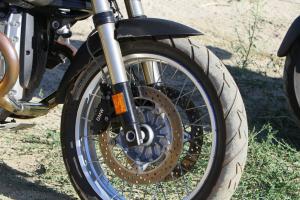 The GS’s brakes aren’t exotic like the Ducati’s potent Brembo package, but they stop the GS with heaps of force nevertheless.
The GS’s brakes aren’t exotic like the Ducati’s potent Brembo package, but they stop the GS with heaps of force nevertheless.
Reach to the Multi’s handlebar is even easier than on the GS; the Duc’s grips fall naturally to hand. And the step in the saddle holds the rider perfectly in place when the throttle is cranked, sending the MTS on its way in rapid fashion.
Hopping off the GS and onto the Multi you’d swear the BMW’s instrument cluster feels a mile away compared to the in-your-face placement of the Ducati’s large LCD panel.
Also in your face on the Multi is its manually adjusted windscreen when set to its highest position. The screen’s proximity to the rider isn’t a genuine drawback or deal breaker by any means, especially for paved-road riding.
However, when standing on the footpegs as you’re apt to do during an off-road-ish excursion, the Duc’s compact cockpit makes it easier for the rider to kiss the top of the windscreen as the front-end dives and then rises again while traversing uneven ground. The BMW’s screen is further from the rider, and therefore helps mitigate the chances of banging your helmet’s chin bar (or worse!) on the top edge of the screen.
The Ducati’s large, all-LCD readout is loaded with dizzying amounts of data – most of it displayed all at once. It’s like the futuristic dash of a concept car. Toggling through the various displays via handlebar switches at first is daunting, but it gets easier with more miles in the saddle.
|
|
|
The BMW’s basic analog speedo and tach, and small-by-comparison LCD panel, is more like the dash in a classic muscle rod at the local car show. The Beemer’s simpler cluster is easier to take in at a glance, but in order to get all the data offered in its LCD a rider has to scroll via the Info button on the left-side switchgear.
The Ducati is as much about style as it is performance, and the GS is a classic illustration of function over form. This pattern follows to each bike’s hard luggage.
The Multistrada’s saddlebags complement the bike’s overall style, but in order to close them they must be locked, and the latch system requires a little finessing in order to ensure the lid is properly shut. Also, the bags seem a bit of an afterthought from Ducati.
The right-side bag suffers serious loss of volume since a large area of the bag is carved away, as if it were accommodating a high-mount exhaust. Yet the Multi’s stubby exhaust exits just behind the right passenger peg. Turns out, the cutout is there to allow hot exhaust to blow past the bag without melting plastic.
|
|
We’re not engineers, but seems like there could’ve been a better design for the exhaust that allows more useable area in the saddlebag. After all, these bikes will likely see lots of sport-touring miles.
The Beemer’s high-mount exhaust definitely impedes full storage capacity of the left-side Vario case, but a mechanical lever inside the case expands the bag outward in order to make up for some of the loss. However, the full capacity right-side bag extends in the same manner. So, cumulatively you gain back a lot of the room lost in the left bag.
Also, the GS’s bags open with the simple push of a button rather than using a key; and they close weather-tight with a soft fumpf. And like Tom noted, they look tougher than Ducati’s boxes.
“If taken off-road, the stylized Duc bags will get scratched and damaged long before the utilitarian BMW luggage,” opined T.Rod. He also made a similar keen observation about the Ducati’s LED turn signal-integrated hand guards suffering more costly repairs if damaged when compared to the GS’s basic but functional hand protection.
 |
A jack-of-all-trades, master of none versus a master of the road
The new Multistrada retains the road-carving DNA of its Ducati superbike brethren. And a class win along with a stellar second-place finish overall in the motorcycle division at this year’s Pikes Peak International Hill Climb speaks volumes of the Multi’s abilities. But Pikes Peak ain’t no Paris-Dakar.
Ducati’s attempt to snatch away market share from BMW in the on-road/off-road segment with the Multistrada 1200 could prove highly successful given what we suspect (and mentioned earlier) is the Adventure-Touring customer’s inclination to keep most adventures of the paved variety.
However, this also presumes consumers will honestly assess where they spend the majority of their two-wheeled miles.
A sportbike rider will find the Multistrada a familiar beast and entirely at home stitching together curve after curve. But if a prospective Multistrada buyer fantasizes about exiting the freeway at No Man’s Land then crossing sandy ravines and effortlessly running over hill and dale on this Italian stallion, they’re fantasizing about the GS but just haven’t realized it yet.
When the trail isn’t paved, the GS excels in every way.
“Even though Ducati has softened the response from the gnarly 1198 mill, the Multi can’t come close to equaling the Beemer’s wonderfully fluid throttle,” Duke comments. “And although the Duc has decent ground clearance, an unseen rock could easily take out the V-Twin’s lightly protected forward exhaust pipe and perhaps even the engine sump. Keep in mind that the “Enduro” mode won’t let you race an enduro!”
|
|
The R1200GS will usually be just a headlight in the Multistrada’s mirror when the day’s route is entirely paved. The Beemer rider will work much harder to keep the Ducati’s on-road pace (unless ridden by some GS uber stud, of which there are many).
But the GS also has 30 years of go anywhere, do anything refinement. So then, on the surface the BMW appears the better value overall in light of its ability to serve a wider selection of consumers. But assigning value is often a subjective process.
The inclusion of rider-selectable engine performance on the Ducati, along with more on-the-fly electronic adjustment capability than the BMW, the Multistrada seems the first bike to have outdone the GS – and therefore BMW – at its own game.
“Use of the same buttons for multiple functions can be aggravating at first,” said Tom of the Ducati’s sometimes-complex electronic hoops, “but the ability to adjust settings on the fly is technology I can get behind.”
But if you’re not in a big hurry most of the time, perhaps pulling to the side of the road in order to push a few buttons on the GS isn’t perceived as a drawback.
“And if you intend your paths to cross any significant off-road sections,” declares Duke, “the GS is much preferable in that environment. This is the clear distinction between this pair of two-wheel SUVs. The Duc is a Porsche Cayenne to the BMW’s Hummer.”
|
|
What we suspected from the beginning only became more obvious in the end. “Neither one of these bikes is superior to the other,” says T.Rod wrapping up his thoughts on this Swiss Army Bike battle.
All you have to do now is figure where you want go and how you’ll get there, and then choose your weapon. Once you pick either the Multi or GS, you’ll have selected the winner.
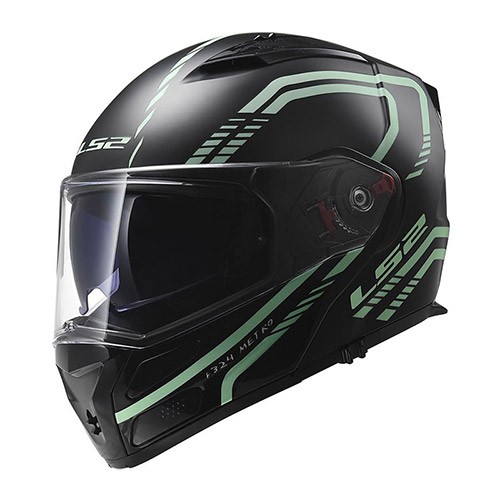
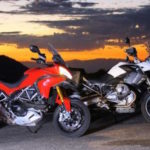
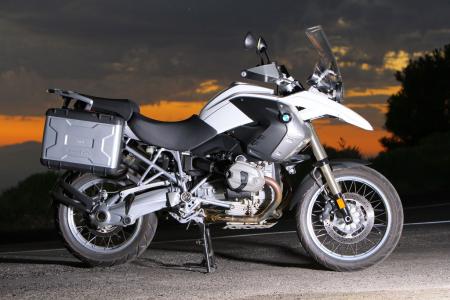 Now 30 years old, the GS is still a force to be reckoned with.
Now 30 years old, the GS is still a force to be reckoned with.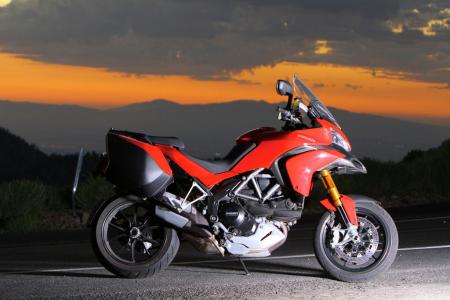 The new Multistrada 1200 is the first bike to contend with the GS on even footing for a piece of the GS’ adventure-touring pie. The Multi brings all the whiz-bang electronic rider aids available to the GS, while going one step further with the addition of rider-selectable engine mapping.
The new Multistrada 1200 is the first bike to contend with the GS on even footing for a piece of the GS’ adventure-touring pie. The Multi brings all the whiz-bang electronic rider aids available to the GS, while going one step further with the addition of rider-selectable engine mapping. It shouldn’t surprise anyone to see the Ducati’s 1198-sourced engine out-muscle the venerable BMW’s Boxer, even with the latter’s new-for-2010 double overhead cams. The Beemer has a clear edge in tractability and smooth throttle response.
It shouldn’t surprise anyone to see the Ducati’s 1198-sourced engine out-muscle the venerable BMW’s Boxer, even with the latter’s new-for-2010 double overhead cams. The Beemer has a clear edge in tractability and smooth throttle response.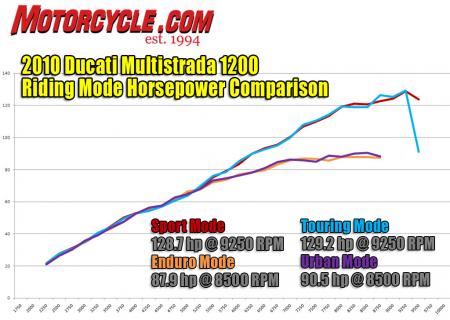 In Sport mode, the Multistrada gives direct access to its full breadth of power and 9500-rpm rev ceiling. Touring mode softens response slightly, and is our favorite, but it doesn’t inhibit peak power like the Urban and Enduro modes that also knock down the rev limit to about 8800 rpm.
In Sport mode, the Multistrada gives direct access to its full breadth of power and 9500-rpm rev ceiling. Touring mode softens response slightly, and is our favorite, but it doesn’t inhibit peak power like the Urban and Enduro modes that also knock down the rev limit to about 8800 rpm.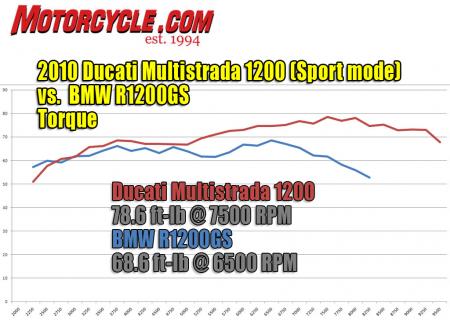 Most mile munching is done at less than 5000 rpm, and the gutsy BMW Boxer holds its own at those speeds. But the Duc is no slouch down low, and it has a marked surplus in power at higher revs.
Most mile munching is done at less than 5000 rpm, and the gutsy BMW Boxer holds its own at those speeds. But the Duc is no slouch down low, and it has a marked surplus in power at higher revs. The GS stands at attention, ready for rugged backcountry exploring. At this proposition, the Multi takes a more relaxed attitude, deciding instead a 120-mph blitz up the canyon followed by a leisurely stop for a cappuccino is about all the adventure it’d prefer.
The GS stands at attention, ready for rugged backcountry exploring. At this proposition, the Multi takes a more relaxed attitude, deciding instead a 120-mph blitz up the canyon followed by a leisurely stop for a cappuccino is about all the adventure it’d prefer.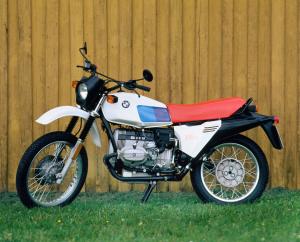 Original gangsta: The R80G/S
Original gangsta: The R80G/S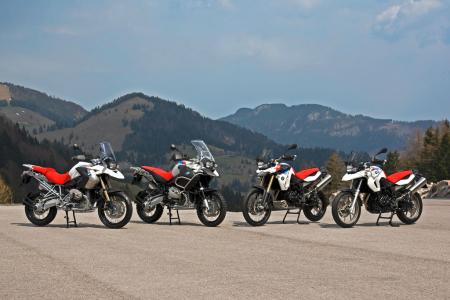 Special-edition Alpine White with red and blue accents indicate a 2010 GS model as a 30th Anniversary GS.
Special-edition Alpine White with red and blue accents indicate a 2010 GS model as a 30th Anniversary GS. The Multi’s large, comprehensive LCD instrument panel is intense!
The Multi’s large, comprehensive LCD instrument panel is intense! The Beemer’s panel is almost rudimentary next to the Ducati’s. However, at a glance, the GS’ analog gauges require less brain processing power.
The Beemer’s panel is almost rudimentary next to the Ducati’s. However, at a glance, the GS’ analog gauges require less brain processing power.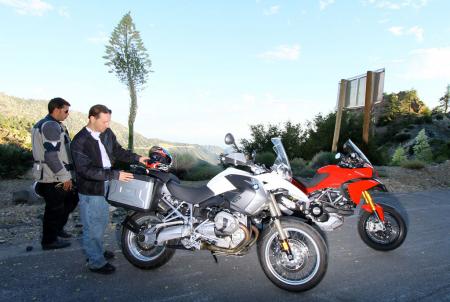 Brawny Vario hard cases on the GS appear better suited for rugged off-road settings, as well as exhibiting a higher level of refinement than the Multi’s bags.
Brawny Vario hard cases on the GS appear better suited for rugged off-road settings, as well as exhibiting a higher level of refinement than the Multi’s bags.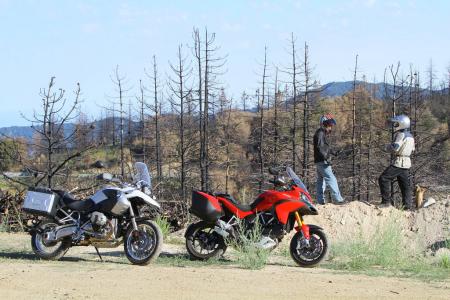 Both motorcycles attempt to woo the rider with an adventurous spirit, but the BMW is still the definition of the do-it-all machine. The new Multistrada is an excellent first effort at an all-‘rounder from Ducati. However, its real strength is in on-road riding where it excels, leaving the BMW as a small image in its mirror.
Both motorcycles attempt to woo the rider with an adventurous spirit, but the BMW is still the definition of the do-it-all machine. The new Multistrada is an excellent first effort at an all-‘rounder from Ducati. However, its real strength is in on-road riding where it excels, leaving the BMW as a small image in its mirror.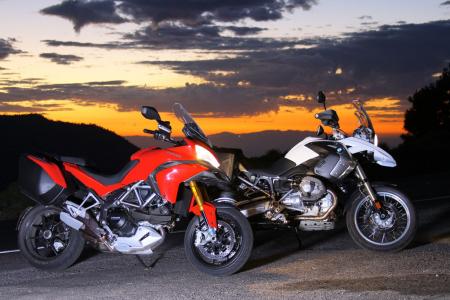 No losers here. Just an Italian dream that rides like a premium-level sportbike with a bolt-upright riding position, and a motorcycle that’ll please most of the people most of the time.
No losers here. Just an Italian dream that rides like a premium-level sportbike with a bolt-upright riding position, and a motorcycle that’ll please most of the people most of the time.